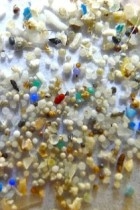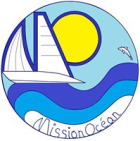Mission Ocean: Stop Using Plastic Microbeads!

With growing concern about the health of our oceans, everyone is talking about microbeads. But what are they, and how do they end up in our oceans and lakes? How can you identify them, and what alternatives are there?
Microbeads are the tiny balls found most commonly in face scrubs and other exfoliating products. But what a lot of people don’t realise is that those little balls are actually made of plastic, and every time we wash our faces or bodies with these products, the plastic goes straight down the plug hole.
One regular tube can contain up to 300,000 tiny balls of plastic. Microbeads are also used in toothpastes, shower gels and even washing powders and liquid tabs.
On shore, the water that goes down our drains is processed in water treatment facilities, before being flushed back into rivers and seas. Unfortunately, microbeads are so tiny that they often don’t get filtered out; those that do will end up in residual solid sludge, which can be used as fertilizer in agriculture. With a good spell of rain, the microbeads will be washed back into streams and rivers.
Onboard, microbeads go straight into the grey water system. Depending on your location, tanks may be pumped in ports and the water treated ashore, but offshore the grey water will be flushed out, sending microbeads (and other products such as soaps, shampoo and washing up liquid) directly into the sea. So if a whole crew is using exfoliating products or toothpastes containing microbeads on a daily basis,it quickly amounts to a large volume of plastic particles.
Once they enter the oceans, microbeads are small enough to be ingested by fish and other fauna, thereby entering the food chain, and recent studies have confrmed an alarmingly high presence of micro-plastics in the fish and seafood that we eat. So these little plastic beads present in our everyday products are going down the drain, through treatment plants, into the sea, and ultimately back to our bellies.
And if that wasn’t bad enough, studies have shown that microbeads are also vectors for all kinds of bacteria and toxic pollutants which are subsequently transported much further afield, spreading disease and disrupting the delicate balance of ocean ecosystems.

So what can be done? First of all, we should all be checking our cupboards to see if there are microplastics in the products that we are using every day.
Here are the top ingredients to look out for:
-
Polyethylene (PE)
-
Polypropylene (PP)
-
Polyethylene terephthalate (PET)
-
Polymethyl methacrylate (PMMA)
-
Nylon (PA)
Chances are, if your shower gel or toothpaste contain one or more of these, they will contain microbeads. They are well hidden and you may not even realise that you are using them – we have had some nasty surprises ourselves!
At the moment there is no easy way to recycle these products, and a lot of websites suggest simply sending them back to the manufacturer with a letter explaining why you won’t be using them anymore. Alternatively, if you are in Europe, you can mail your products to us at Mission Ocean. We are working on solutions to filter and recycle them, and can stock them until this is in place. Give us a call or drop us an email to organise a collection.
If you are in the States you can mail the products to the 5 Gyres Institute, an NGO that is collecting plastic products to use in educational kits: 5 Gyres Institute, 3131 Olympic Blvd, Santa Monica, CA 90404.
 |
 |
As a minimum, you can always seal the containers and throw them away. Whilst this is not ideal, and definitely not a long term solution, microbeads are better in the bin than in the ocean.
The good news is that there are plenty of natural alternatives out there, and they are appearing in more and more off-the-shelf products. Walnut shells, sugar, sea salt, and even coffee grounds make great exfoliating agents, and are often much more effective than plastic beads, so you’ll end up using less product and also save money.
You can even consider making your own exfoliating scrub: olive oil + sea salt + a drop of essential oils will do just the trick!
We are well aware that becoming more eco-friendly sounds like hard work and requires us to change some habits, but there are simple actions that we can all take, like banning microbeads from our lives, which will make a massive difference to the future of our planet.
Want to find out more? Here are some useful links:
Beat the Microbead
5 Gyres Institute
Or contact us at Mission Ocean!
*Image credits: Oregon State University BY SA 2.0 via Flikr ; Thegreenj CC-BY-SA-3.0 via Wikimedia Commons


Post your comment
You cannot post comments until you have logged in.
Login to post a commentComments
No one has commented on this page yet.
RSS feed for comments on this page | RSS feed for all comments